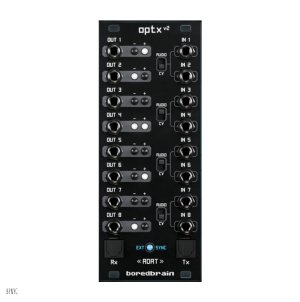Boredbrain Optx V2 次回入荷分
Optx v2
ADAT OPTICAL CONVERTER
- Bi-directional ADAT lightpipe encoding/decoding of 8 analog inputs/outputs
- Switchable input mode (in pairs) powered by high-performance Cirrus Logic converters
- AUDIO input mode ensures the highest fidelity possible with ultra-low noise
- Self-calibrating CV input mode provides exceptional accuracy and near-zero offset (DC-coupled)
- Precision DC-coupled outputs support both audio and CV signals
- Internal sample clock permits one-way operation without ADAT input and standalone interconnection of two Optx modules
- Dual LEDs on each output indicate signal strength and polarity
Next generation ADAT conversion
Optx v2 is a pro-quality ADAT lightpipe converter for eurorack modular synthesizers. The DC-coupled module can encode and decode audio signals with extremely low noise, and CV signals with near-zero offset. Additionally, on-board sample clock allows for one-way ADAT output and the ability to be used standalone to interconnect eurorack systems.
ADAT Encoding & Decoding
Many computer audio interfaces are equipped with one or more pairs of ADAT expansion ports allowing for additional input and output channels. Optx v2 takes full advantage of these often unused ports, providing multi-channel connections directly to and from eurorack systems.
The module accepts any 8-channel ADAT encoded digital signal at the Rx TOSLINK jack (via lightpipe optical cable) and converts it into 8 discrete analog signals. Conversely, Optx v2 accepts 8 discrete analog signals and converts them into an 8-channel ADAT encoded digital signal available at the Tx jack.
When used in conjunction with software such as Bitwig Studio or Ableton CV Tools, Optx v2 is an excellent interface not just for audio, but also control voltages like 1V/oct pitch and gate signals, or LFOs, ADSRs and other modulators.
Precision and Performance
Optx v2 has been fitted with high-performance op amp input buffers and professional-grade Cirrus Logic analog-to-digital converters with extremely low noise and distortion, maximum dynamic range, and excellent overall detail. The inputs and outputs have very precise level scaling with a range of 20 Vpp (±10 V). Thus a typical eurorack audio signal of 10 Vpp will translate to exactly -6 dBFS, while maintaining an equal amount of headroom.
The module’s high-quality analog outputs, OUT 1-8, are DC-coupled and support both audio and CV (control voltage) signals at all times.
The module’s analog inputs, IN 1-8, also accept both audio and CV signals. To ensure the best possible quality and precision, each pair of inputs has a front-panel switch that selects the conversion mode appropriate for each of these two signal types.
In AUDIO mode, the selected input pair is AC-coupled by enabling high-pass filters within the ADC. This guarantees that the audio signals are converted with no DC offset and the best possible signal-to-noise ratio.
In CV mode, the selected input pair is DC-coupled, and CV signals are converted with accuracy and precision. When switched into CV mode, the input pair undergoes a self-calibration period of 5 seconds to detect and then actively correct any inherent DC offset.
Note: For critical CV input signals such as 1V/oct pitch, re-calibrating after warm-up (25 minutes) can yield even better accuracy.
On-board Sample Clock
Sample clock synchronization is essential for high-quality digital conversion that is accurate and free from jitter. Like its predecessor, Optx v2 can either sync to an external sample clock via ADAT input, or produce its own stable clock so that other devices can instead sync to the module.
There are two settings for sample clock sync selectable using dip switches on the back of the module. The first switch, SYNC, selects whether Optx v2 syncs to an external sample clock (EXT) or to its own (INT). The second switch, RATE, determines the sample rate of the on-board sample clock (44.1 or 48 kHz).
| SYNC | |
|---|---|
| INT | Generates and syncs to internal clock |
| EXT (default) | Syncs to external clock from ADAT Rx |
| RATE | |
|---|---|
| 44.1 | Internal sample clock is set to 44.1 kHz |
| 48 (default) | Internal sample clock is set to 48 kHz |
For a typical two-way ADAT connection with an audio interface, it is recommended to sync Optx v2 to the external clock of the interface by setting the SYNC switch to EXT. This requires a valid ADAT signal at the Tx jack, and is acknowledged by the BLUE LED labled EXT SYNC.
If the audio interface does not have an ADAT output port, Optx v2 can provide sample clock to the interface by setting the SYNC switch to INT and choosing the desired sample rate with the RATE switch.
It is also possible to directly interconnect two Optx modules (v1 or v2). This is similar to the two-way connection with an audio interface. In this case, one Optx must be set to internal sample clock sync (INT) and the other to external sync (EXT).
Note: For users of Push 3, the simplest configuration is to set Optx v2 to EXT and ensure Push 3 is set to Internal sample clock sync of either 44.1 or 48 kHz. The blue LED should illuminate indicating proper sync.

Signal LEDs
Optx v2 also provides visual signal indication of the 8 decoded ADAT channels feeding the OUT 1-8 jacks. Each pair of WHITE LEDs indicates the polarity (-Ve left, +Ve right) and relative strength of the signal (±10 V).
Audio-rate signals will generally light both LEDs continuously, whereas LFOs will alternate more apparently between the two. Gates, triggers and positive-going envelopes will generally light only the right LED (+Ve).
+5 V Power Source
Some of the circuitry within Optx v2 requires a +5 V power source. This source can be selected using a jumper on the back of the module. When set to OPTX, the module will create +5 V from the +12 V power rail. When set to CASE, the module will use +5 V supplied by the PSU in the case.
technical specs
- Width: 10 HP
- Depth: 1.5 in (38 mm)
- Weight: 4 oz (113 g)
- Resolution: 24 bit, 44.1/48 kHz
- Max I/O Level: ±10 V (20 Vpp)
- Input impedance: 50 kΩ
- Input SNR: > 103 dB
- Power (1): +12 V 260 mA, -12 V 130 mA
- Power (2): +12 V 130 mA, -12 V 130 mA, +5 V 270 mA

patch tips
CV/GATE/MOD & AUDIO RETURNS – Use CV capable software such as Bitwig Studio or Ableton CV tools to send pitch, gate, and modulation signals to Optx outputs. Patch them respectively into a 1V/oct oscillator, envelope gate input, and filter cutoff control. Then patch the audio signal(s) back to the Optx inputs to mix within the DAW software. Instrument tracks can then contain both the sequence data and audio returns for simple and powerful integration with your eurorack synth.
NOTE: 1V/oct signals will require calibration within the software.
DRUM TRIGGERS & AUDIO RETURNS – Using a drum rack in one of the aforementioned CV capable softwares, send up to 8 drum triggers to Optx outputs. Patch them into trigger inputs of drum modules, envelopes, etc. Now patch their respective audio signals back to Optx inputs to mix and process within the DAW.
NOTE: Some drum modules are responsive to varying trigger voltage. If the trigger CV output level is modulated using velocity/etc in the software, then Optx will dynamically produce trigger voltages based on velocity!


販売価格: 56,948円 [通常販売価格: 61,900円]
重さ: 1lb





